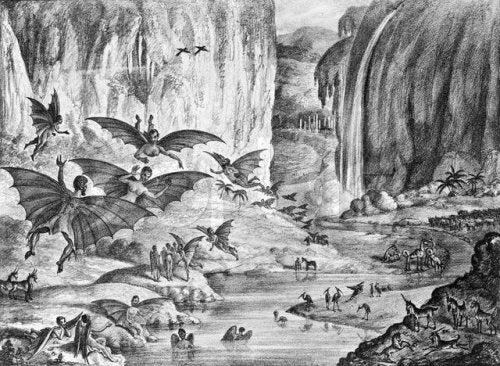Beginning on August 25, 1835, The Sun (New York) began a series of erroneous stories falsely attributed to famed English astronomer Sir John Herschel detailing his January 1835 lunar observations from the Cape of Good Hope. Written by Richard Adams Locke, these installments were based off accounts covered in the Edinburgh Journal of Science. The main problem with this report so far: that academic journal had ceased publication years earlier.
While it is true that Herschel was in South Africa from 1834 to 1835, he was there primarily to spy Halley’s Comet. Herschel’s presence at the cape and his observations of cosmic targets are about the only pieces of truth in Locke’s serial.
Although the first day’s account provided background of Herschel’s observations and brief descriptions of lunar targets, day two saw the first reporting of absurd accounts of lunar denizens. Among these creatures were bison, goat-like animals, pelicans, and the evasive lunar fish.
- It carries its young in its arms like a human being, and moves with an easy gliding motion. Its huts are constructed better and higher than those of many tribes of human savages, and from the appearance of smoke in nearly all of them, there is no doubt of its being acquainted with the use of fire.
While subsequent columns continued to report amazing creatures, flora, and topography of the lunar surface, Locke saved the best for last: an advance race of temple-builders, the Vespertilio-homo, or bat-like, winged humans.
The report occasionally detailed various nights of cloudy weather that were unfavorable for observing. Astronomers of today can tell you how frustrating it is when you plan a night of observing lunar bison and miniature zebras, only for weather to cancel the session.
Locke’s primary intention of the serial was satire. Bothered by unsubstantiated scientific reports, he wrote the accounts as a jab at “scientists” whose sensationalized theories were based on speculation more so than fact. In closing, on day four, Locke alluded to this target in words attributed to Herschel:
- I by no means despair of ultimately solving not only these but a thousand other questions which present themselves respecting the objects of this planet; for not the millionth part of her surface has yet been explored, and we have been more desirous of collecting the greatest possible number of new facts, than of indulging in speculative theories, however seductive for the imagination.
As for Herschel, he initially found the accounts comical, lamenting (tongue firmly in cheek) that his actual observations would never be as exciting. Eventually, the humor turned into annoyance as, over time, Herschel continued to field questions by duped believers of the Great Moon Hoax of 1835.










